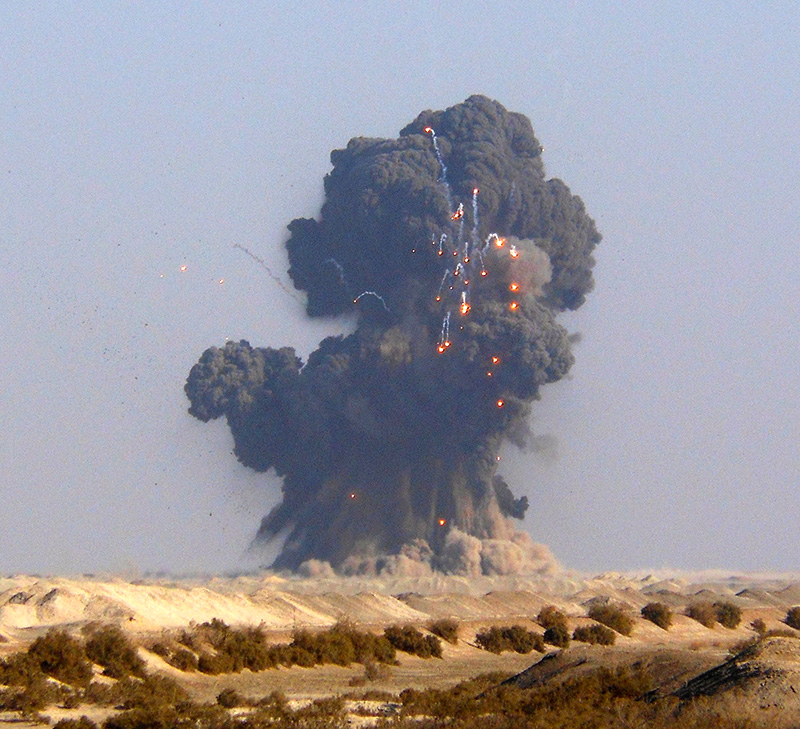For the past 15 years, SafeLane Global has been actively enabling a safer Kuwait, surveying for and clearing explosive remnants of war and landmines in oil fields and across former major battle sites to ensure the Kuwaiti people have remediated land returned to them.
1 - History of the conflict in Kuwait
On the 2nd of August 1990, Kuwait was invaded by Iraq, an event which led to the Gulf War which lasted the six weeks between the 17th January to the 28th February, 1991.
Kuwait faced a myriad of naval and aerial bombardments including heavy bombing of their capital, Kuwait City. Much of the conflict occurred within Kuwait City and the areas surrounding the Iraq-Kuwait border, primarily transpiring on land.
2 – Landmines and UXO within Kuwait
As a result of the Gulf War large areas remain contaminated by landmines and unexploded ordnance (UXO). Despite efforts to clear the explosive threat over the years vast areas remain contaminated.
Further conflict occurred during the United States of America’s invasion of Iraq in 2003, during which troops from varying nations were situated in Kuwait
Below are some examples of ERW that have been found within Kuwait since 1991:
- Artillery munitions
- Anti-tank & anti-personnel mines
- Missiles
- Hand grenades
- Rocket propelled grenades
- Cluster munitions
- Mortars
- Air-dropped bombs
There are still land mines in Kuwait, particularly along sand corridors. However, the exact location of the landmines present in Kuwait is still unknown. Kuwait’s shifting, sandy landscape further complicates the survey and clearance process since items can shift location and depth.
3 – The ongoing impact of explosive ordnance in Kuwait today
Over three decades later, these remnants of war still pose a significant threat to Kuwait’s well-being. Between 1990 and 2017, there were 1,486 casualties from mines and ERW. Kuwait reportedly has the highest number of mines per square kilometre globally.
The risks of UXO and landmines severely limit the oil industry, infrastructure development, housing, travel, and overall livelihoods within Kuwait.
4 – SafeLane Global supporting Kuwait with survey, clearance and consultancy
For over 20 years, SafeLane Global has been actively promoting a safer Kuwait, offering safe and efficient area survey and clearance. After years of operating within the country, SafeLane advocates the Kuwait National Development Plan.
Al Mutlaa, a part of Kuwait’s National Development Plan and their 2035 vision, is the largest housing project in Kuwait, aiming to house 170,000 residents over 42km2 of land in 28,288 houses.
Unfortunately, this land was contaminated by UXO. SafeLane has assisted by conducting extensive UXO surveys and clearance operations which began in March of 2019 and continued even during the global pandemic. The project was successfully completed in January 2021.
SafeLane used a combination of techniques and technologies such as push-cart magnetometer systems to identify sub-surface explosive hazards.
Demand for housing is high in Kuwait and is constantly rising. SafeLane is proud to clear land to aid the development of Kuwait and to support the livelihood of its people.
SafeLane Global has worked in the Burgan Oil Field which was a battleground in the 1st Gulf War, like many other Kuwaiti oil fields. The Burgan Oil Field contained a vast amount of UXO despite numerous clearance efforts over the last 25 years by various organisations.
Over the years SafeLane have supported the Kuwait Oil Company (KOC) and successfully carried out Mine Sweeping and Battle Area Clearance ahead of Seismic Surveys.
5 – Kuwait and SafeLane Global today
SafeLane continues to assist the Kuwaiti government whenever possible, providing solutions for handing over risk-free land, clear of contaminants to the people of Kuwait. By providing our services, Kuwait can continue development and regeneration of their land and communities.
For more information about SafeLane Global’s projects in Kuwait, please read the case studies below.
To enquire about how we can support your project in Kuwait or any other nation globally, please contact the team at SafeLane for a rapid and comprehensive response.
Frequently Asked Questions About Kuwait:
What is the Al Mutlaa project?
The Al Mutlaa project is part of Kuwait’s 2035 vision – it is a residential infrastructure project that aims to house over 400,000 people. SafeLane Global has been assisting this project by surveying and clearing the land of explosive contaminants.
Where is Kuwait?
Kuwait is a small emirate located between Iraq and Saudi Arabia. It is situated in a section of one of the driest deserts on Earth and yet it also borders the Persian Gulf.
Is Kuwait safe?
When it comes to the prevalence of explosive ordnance in Kuwait, everyone from the government to individual construction or energy companies takes the threat seriously. It is why SafeLane is commissioned to deliver the required mitigation solutions - from survey to clearance.
Is Kuwait a developed country?
Absolutely yes - it is a high-income economy backed by the world's sixth largest oil reserves. In addition, its currency, the Kuwaiti dinar is the highest valued currency in the world.


